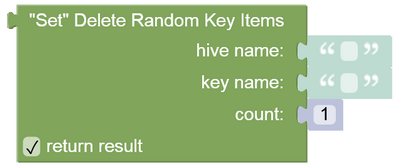Delete Random Key Items¶
Description¶
This operation returns the specified number of random elements and deletes them afterwards from a set.
Method¶
Backendless.Hive(hiveName).SetStore(keyName).getRandomAndDelete(count): Promise<values[]>;
where:
| Argument | Description |
|---|---|
hiveName |
Name of a hive where the operation is performed. String value. |
keyName |
Key name identifying a set. String value. |
count |
Optional parameter. Identifies the number of values to delete and return in the response. Defaults to 1. |
Return Value¶
An array containing deleted values. Each individual value is of any data type.
Example¶
The example below returns two random values and deletes them from the 'cars' set. By specifying the count parameter you can return/delete the specified number of elements.
await Backendless.Hive('transport').SetStore('cars').getRandomAndDelete(2)
where:
| Argument | Description |
|---|---|
'transport' |
Name of a hive where the operation is performed. |
'cars' |
Key name identifying a set. |
Response Example¶
[
"Sedan",
"Crossover"
]
Codeless Reference¶

where:
| Argument | Description |
|---|---|
hive name |
Name of a hive where the operation is performed. |
key name |
Key name identifying a set. |
count |
Specify the number of items to delete. |
Returns a list containing deleted values.
Consider the following Set storage:
The example below deletes a random value from the "cars" set:

The logic produces the following output:
